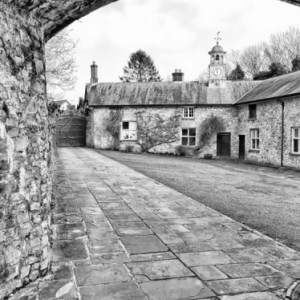Welsh Folk Museum
It was a nice day, and with Mrs BB working, I took a walk through St Fagans Welsh Folk Museum, Cardiff. Entry is free and there's lots to see and do. The main photo shows St Teilos church and the extra is the old Stable block. Both taken in B&W.
The old parish church of St.Teilo at Llandeilo Talybont, near Pontarddulais, South Wales, has a long history. It seems likely that the site has been used as a place of Christian worship since the 6th century, though nothing older than the 13th century now remains. Two small transepts or chapels were added to the north and south of the building in the late 14th century, and linked by arches to the chancel. The north chapel was known as the Gronow Chapel presumably after its benefactor. A century later, an aisle was added to the south of the nave, the old south wall being replaced by two arches, and a squint opening formed through one of the side walls of the chancel arch. Finally a porch was erected at the entrance door leading to the south aisle.
The Welsh place-name Llandeilo Talybont, 'the church of St.Teilo at the head of the bridge' refers to the first crossing point of the river with its ancient settlement alongside, near the Roman fort of Leucarum (Loughor), whereas the situation of the old church itself, in a tidal marsh on the river Loughor, gives it its locally known name: 'the Church of St.Teilo on the Marsh'.
This Parish Church was in constant use until 1852 when a new church also dedicated to St.Teilo was built for the growing town of Pontarddulais. Services were then held three times a year in the old church until 1971. From then on the condition of the old church worsened. In Autumn 1984 the roof slates were stolen, and due to it being often surrounded by flood water, subsidence was causing the fabric of the building to crumble. This deterioration together with access problems made the church impossible to save in its original location, though great efforts had been made by local societies and councils.
The Welsh Folk Museum became interested in the church in 1982, when it was decided to bring one of the increasing number of redundant church buildings to St.Fagans. St.Teilo's seemed to meet their requirements, being a late Mediaeval Church, little altered in the Victorian period, and known to include wall- paintings of more than one period.
The Church in Wales and local councils supported the idea of moving the church and CADW gave its permission, the church being a scheduled ancient monument. An emergency operation to reveal and record the wall paintings was undertaken in December 1984 by staff of the Royal Commission on Ancient Monuments in Wales. Eventually, a team from the Department of Archaeology at University College Cardiff, began work to conserve the paintings
The quantity and quality of the wall paintings proved to be a major find, many being the best in Wales some the best in Britain. The earliest is of about 1400, showing St. Catherine, and some time around 1500, the entire church had been re-painted with scenes showing the Passion of Christ as well as a large painting of St. Christopher in its traditional place opposite the door, and the window reveals and the undersides of arches were covered with figures and patterns. With the Reformation, these would have been whitewashed In 1751, the church was repainted again with texts and a huge Royal Arms, but within thirty years, the churchwardens had applied for permission to cover these.
During 1985, all the wall paintings were either recorded or removed for treatment. The roof was dismantled and taken to St.Fagans and the rest of the church measured in detail. The building was finally taken down in 1986 awaiting removal and eventual re-erection at the Folk Museum (now known as The Museum of Welsh Life). It is hoped eventually, to re-instate the early wall paintings in the church, making good the missing portions, so that St.Teilo's will look as near as possible as it did five hundred years ago, glaring white outside, and a blaze of colour within. It will be the only medieval parish church in Britain to have been entirely removed to another site.


Comments
Sign in or get an account to comment.


